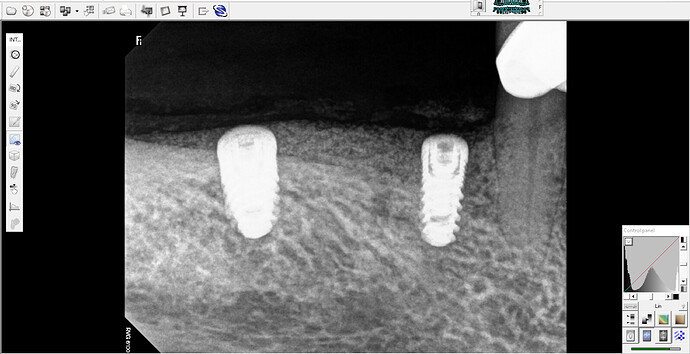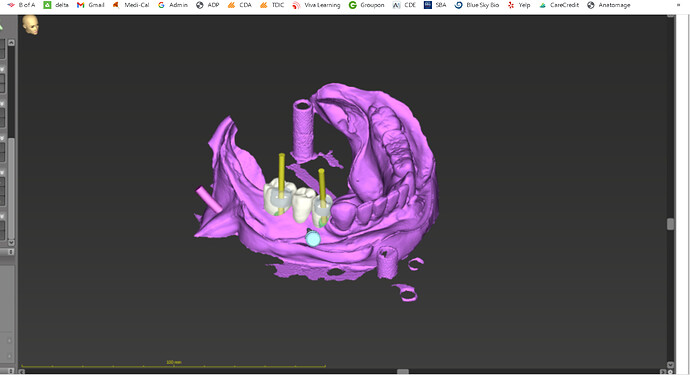Hi everyone. This is my first post here. This pt came to me with a bridge out on LR . Took out 28 and 30 May 2021 and grafted . Used guide and had a hard time even free handing #30 due to limited opening. I had no choice but to place the implant in and buccally at least 3 threads were showing even though the lingual is at the crest. I placed lots of BioOss and membrane and closed it. I have not been sleeping because I am afraid it will fail. What do you think? Should I take it out and force her to open so I can sink it deeper with new implant??? Should I take out graft wait 6 months and go back? Should I wait 3 months and take another CBCT and see what happens? Should I wait 4 months for integration and prep the exposed threads and include in the bridge prep and cement? Please let me know and I have attached my x-ray and the Tx plan of how it should've ended up. thanks so much for your input
Neil Zachs- periodontist comments:
Leave it alone…a few threads exposed is not make or break. Let’s hope your graft works and things will be stable. Make sure you test the ISQ value of the implants at uncover. That’s important. Second…DO NOT make this a cement retained restoration!!! This should be screw retained only. Use an angled screw channel if you have to. The chance of retained cement in this case or any for that matter…that would just lead to more bone loss. Look retrospectively…the thing you possibly should have done differently is wait and hold off on doing the case until the patient could have opened to all for an implant in the 30 area. 30 is not that far distal so maybe there was an issue with the patient that day…or you could have considered IV sedation to allow better opening so you could have placed the implant in a better positionDr Pravin patel Mumbai comments:
Relax,relax,relax..it will integrate and bio oss will surely form bone..in worst case scenario even some thread opening won't give any problem..make sure it's under gums and not much open threads visible intra orally for plaque..best of luck..just wait for 4-5 months to integrate properly..such things is not un common for implantologists.Brian G comments:
OH NO! I can’t believe you did something that has happened to, most likely, 3/4 of the people on here. It’s not going to affect much at all. I agree with screw retained.Dr K Gilani comments:
I would want to bring the patient back and put a medium or large bite block into his/her mouth to see how that would feel. If ok, I would do the same with reInsertion of a new implant at a correct height. If you can’t use those bite blocks on the patient then leave it and document it, but even that documentation won’t help you if challenged. And yes don’t use cement wherever you can. Good luckTim Carter comments:
I would be more concerned about the fact that you “placed lots of Bio OSS” than I would the exposed threads. Placing excess material likely required excess release and advancement of the tissue possibly causing excess pain and swelling. I routinely place implants in thin ridges with threads exposed and rarely need any material other than the bone harvested from the flutes of the drill. As long as you have adequate gingiva there is no problem and if placing implants is something you plan to continue I would suggest that you view this as a variation of normal.Jigsaw comments:
This implant will integrate for sure. It’s the perfect implant placements that fail for no reason….AJ comments:
Don't lose a minute's sleep over this. Your case will be successful. Restricted openings are always a challenge. Straumann has a cool device to use during the consultation appointment to gauge the required mouth opening If you're worried about integration , just wait a bit longer before going to the restorative phase. Interestingly enough, I only place tissue level implants in the posterior region, as aesthetics is not a concern for my patients. Function is .Greg Kammeyer, DDS, MS comments:
I'll be the dissenting opinion. I wouldn't want a brand new implant to start off with threads showing. If the bone graft and soft tissue closure cover it and stay covered GREAT. On all implants, as soon as I see metal showing at the gingiva, I assume the ROUGH, NON_CLEANABLE part of the implant is next. Typically this is due to lack of 2-3mm height of keratinized tissue and/or lack of adequate tissue thickness ( 1.7mm). If you do soft tissue grafting, that is typically how I solve exposed metal. We all have had about every problem that shows up here. It's how you handle it that matters.I’m stunned that so many surgeons would leave rough metal exposed >>> inflammation>>> patient avoids>>> recession continues ALONG WITH BONE LOSS.
periodontist also comments:
tissue graft at 2nd stage may help if metal exposed, as long as adjacent bone levels will allow ample blood supply for CTG

